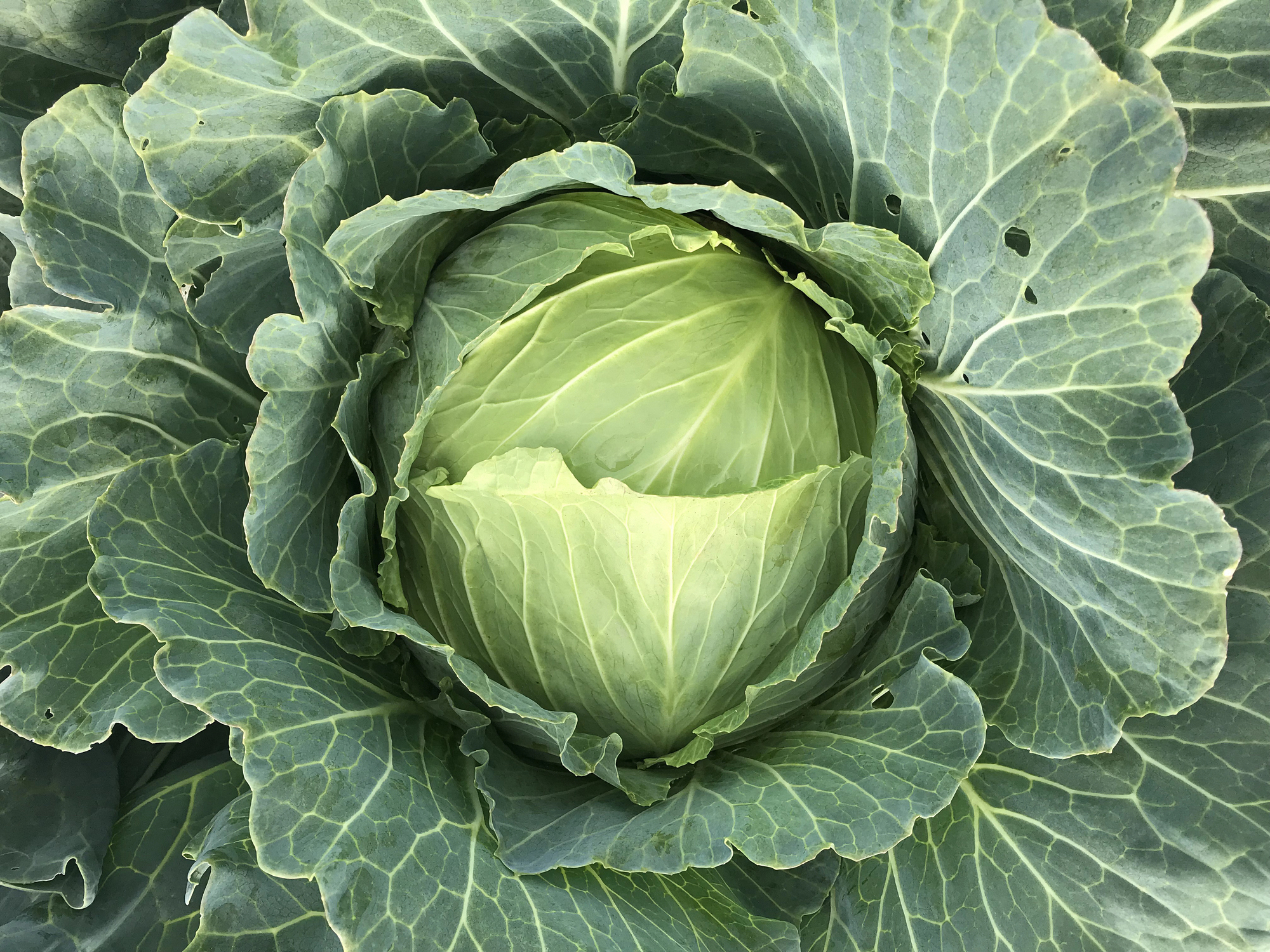Cabbage Donation Tracker
Quick Links: How & Where to Grow | Temperature | How to Care For | Harvest Signs | Harvesting | Pruning | Pests | Companions | Varieties | Preservation | Recipes | Michigan Tips | Fun Facts
🌱 How & Where to Grow Cabbage:
- Start indoors 4-6 weeks before frost for spring.
- Direct seed July-August for fall – fall cabbage is sweeter and stores better!
- Space plants 12-24 inches apart depending on variety size.
- Sunlight: Full sun (6+ hours) but tolerates partial shade.
- Soil Type: Rich, well-drained soil with pH 6.0-6.5.
- Soil Amendment: Heavy feeder – add lots of compost and aged manure
Cabbage loves cool weather – it’s one of the most cold-hardy vegetables you can grow!
🌡️ Temperature Guidance:
Thrives 60-65°F. Withstands 20°F. Avoid extended <45°F on seedlings.
- Optimal growing: 60-70°F days for best head formation.
- Cold tolerance: Mature plants survive down to 20°F.
- Prolonged exposure below 45°F can trigger bolting in young plants.
- Heat above 80°F causes loose heads and bitter flavor.
Michigan’s cool springs and falls are perfect – summer heat is the real challenge!
💧 How to Care for:
- Consistent Moisture: Essential for steady growth and sweet flavor.
- Watering: 1-1.5 inches weekly – even moisture prevents splitting.
- Mulch: 2-3 inches to maintain moisture and cool soil.
- Fertilizer: Side-dress 3 weeks after transplanting.
- Support: Hill soil around stems as plants grow.
📏 Harvest Signs:
Firm, solid heads. 1-3 pounds typical. Before splitting.
- Squeeze test – heads should feel rock solid!
- Size varies by variety – know your type’s mature size.
- Harvest promptly when firm to prevent splitting.
- If heads start splitting, harvest immediately.
Pro tip: Twist plants 1/4 turn to break some roots and slow growth if you need to delay harvest!
🧺 Harvesting:
Cut at base with sharp knife. Leave wrapper leaves for storage.
- Always cut in morning when heads are crisp.
- Cut low on stem for potential second crop.
- Leave outer leaves on storage cabbage for protection.
- Handle carefully – bruising reduces storage life.
- Small heads often form if you leave stem after harvest!
✂️ Pruning:
Remove damaged leaves. Optional: harvest outer leaves. Root pruning to delay harvest.
- Remove yellowing or damaged lower leaves for airflow.
- Harvest outer leaves before head formation for early greens.
- Root pruning: Insert spade 6 inches from plant to slow growth.
- Twist plant 1/4 turn to break roots and prevent splitting.
- Leave stem after harvest for small secondary heads.
🪲 Michigan Pests:
Cabbage worms (Bt spray), aphids, cabbage maggots.
- Cabbage worms – green caterpillars, use Bt or row covers.
- Cabbage loopers – similar damage, same treatment.
- Aphids – gray-green clusters, blast with water.
- Cabbage root maggots – use paper collars at planting.
- Flea beetles – tiny holes in leaves, row covers help.
🫱🏽🫲🏼 Companions:
Onions, garlic, marigolds, dill. Avoid tomatoes, strawberries.
- Onions and garlic repel many cabbage pests.
- Dill attracts beneficial wasps that prey on cabbage worms.
- Marigolds deter aphids and other pests.
- Beets and chard make good space-saving companions.
- Avoid tomatoes and other nightshades – compete for nutrients.
🥬 Varieties:
Early: ‘Earliana’. Storage: ‘Late Flat Dutch’, ‘Savoy Chieftain’.
- ‘Earliana’: 60 days, compact heads for spring.
- ‘Late Flat Dutch’: 100 days, huge heads, stores 6 months.
- ‘Savoy Chieftain’: 85 days, crinkled leaves, cold hardy.
- ‘Red Express’: 63 days, early red variety.
- ‘Storage’: 95 days, bred for long storage.
🫙 Preservation:
Sauerkraut (3 tbsp salt/5 lbs). Freeze blanched. Root cellar 6 months.
- Sauerkraut: Traditional fermentation – 3 tbsp salt per 5 lbs cabbage.
- Root cellar: Whole heads with roots, 32-40°F, 90% humidity.
- Freezing: Blanch wedges 3 minutes, not ideal texture.
- Refrigerator: 2-3 months in crisper drawer.
- Kimchi: Korean fermented cabbage with spices.
- Dehydrating: Makes cabbage chips or powder.
🧑🏽🍳 Recipes:
Golumpki, braised red cabbage, coleslaw, cabbage-sausage skillet.
- Stuffed cabbage rolls (golumpki) – Polish comfort food.
- Sweet and sour braised red cabbage.
- Classic creamy coleslaw or vinegar-based slaw.
- Unstuffed cabbage roll soup – easier than rolls!
- Roasted cabbage steaks with garlic butter.
✋🏼 Michigan Tips:
- Fall crops superior to spring in Michigan.
- Start fall crops in flats during July heat.
- Row covers essential for pest control.
- Choose split-resistant varieties for spring.
- Michigan’s humidity perfect for cabbage growth.
- Storage varieties can last until March in root cellar.
🧠 Fun Facts:
- 91% water but packed with vitamin C.
- Can produce multiple heads.
- One cup of cabbage has only 22 calories.
- Captain Cook prevented scurvy with sauerkraut on voyages.
- World’s largest cabbage weighed 138.25 pounds!
- Cabbage has been cultivated for over 4,000 years.
- Romans believed cabbage prevented drunkenness.
- Michigan grows over 200 acres of cabbage commercially!


0 Comments